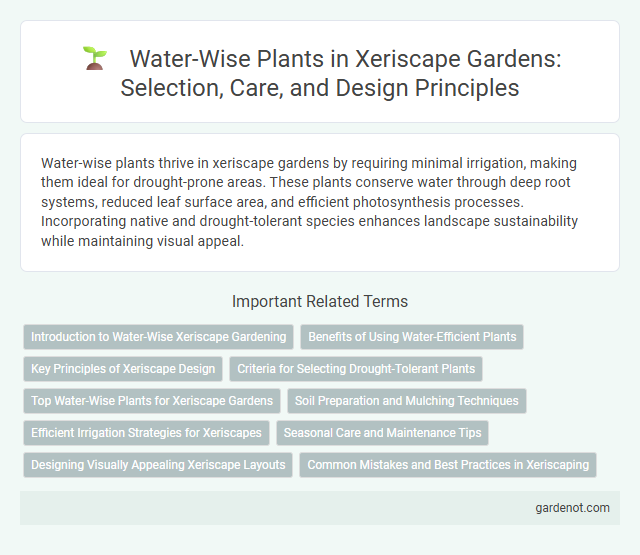Water-wise plants thrive in xeriscape gardens by requiring minimal irrigation, making them ideal for drought-prone areas. These plants conserve water through deep root systems, reduced leaf surface area, and efficient photosynthesis processes. Incorporating native and drought-tolerant species enhances landscape sustainability while maintaining visual appeal.
Introduction to Water-Wise Xeriscape Gardening
Water-wise xeriscape gardening emphasizes the use of drought-tolerant plants such as succulents, native grasses, and perennial herbs that thrive with minimal irrigation. These plants adapt to arid conditions by storing water, reducing evaporation, and adapting root systems to maximize moisture uptake. Integrating water-wise plants in xeriscaping conserves water resources while maintaining vibrant, sustainable landscapes in drought-prone regions.
Benefits of Using Water-Efficient Plants
Water-efficient plants in xeriscaping significantly reduce irrigation needs, conserving water resources and lowering utility costs. These drought-tolerant species enhance soil health by promoting natural moisture retention and preventing erosion. Their adaptability to arid environments supports sustainable landscaping efforts and biodiversity preservation in water-scarce regions.
Key Principles of Xeriscape Design
Water-wise plants in xeriscape design thrive by selecting drought-tolerant species that require minimal irrigation, such as succulents, native grasses, and Mediterranean herbs. Key principles of xeriscape design emphasize soil improvement through organic amendments to enhance water retention, strategic plant grouping based on water needs, and efficient irrigation methods like drip systems to reduce water waste. Implementing mulches further conserves moisture and controls weed growth, ensuring sustainable landscaping in arid environments.
Criteria for Selecting Drought-Tolerant Plants
Drought-tolerant plants in xeriscaping are selected based on their ability to thrive with minimal water, high heat resistance, and adaptability to local soil conditions. Key criteria include deep root systems for efficient water absorption, reduced leaf surface area to minimize transpiration, and natural drought-deciduous behavior to conserve moisture. Choosing native or well-adapted species such as lavender, agave, or yucca enhances landscape resilience while reducing irrigation needs.
Top Water-Wise Plants for Xeriscape Gardens
Succulents like Agave and Aloe Vera thrive in xeriscape gardens due to their exceptional drought tolerance and minimal water requirements. Native grasses such as Blue Grama and Buffalo Grass provide durable ground cover while conserving water. Lavender and Russian Sage are aromatic perennials that not only add color but also endure arid conditions, making them ideal choices for sustainable xeriscaping.
Soil Preparation and Mulching Techniques
Water-wise plants thrive in well-prepared soil that enhances moisture retention and drainage, crucial for xeriscape landscaping. Incorporating organic matter such as compost improves soil texture and nutrient content, supporting deep root development for drought resilience. Mulching with materials like bark, gravel, or straw reduces evaporation, moderates soil temperature, and suppresses weeds, optimizing water conservation in arid environments.
Efficient Irrigation Strategies for Xeriscapes
Efficient irrigation strategies for xeriscapes prioritize water-wise plants such as succulents, native grasses, and drought-tolerant shrubs that thrive with minimal water. Implementing drip irrigation and soil moisture sensors ensures precise watering by delivering water directly to root zones, reducing evaporation and runoff. Using mulch and grouping plants by similar water needs further enhances water conservation and promotes sustainable xeriscape maintenance.
Seasonal Care and Maintenance Tips
Water-wise plants thrive in xeriscape gardens by requiring minimal irrigation, especially during dry seasons. Regular pruning of drought-tolerant species such as lavender, sedum, and yucca enhances airflow and reduces water waste, promoting healthier growth cycles. Seasonal mulching and monitoring soil moisture levels prevent overwatering and help maintain optimal hydration throughout varying weather conditions.
Designing Visually Appealing Xeriscape Layouts
In xeriscape design, selecting water-wise plants such as succulents, native grasses, and drought-tolerant shrubs creates a sustainable and visually appealing landscape. Incorporating varied textures, colors, and heights enhances the aesthetic appeal while minimizing water usage. Strategic placement of these plants around hardscape elements ensures an attractive, low-maintenance garden that thrives in arid conditions.
Common Mistakes and Best Practices in Xeriscaping
Choosing drought-tolerant species like succulents, native grasses, and Mediterranean herbs is essential for successful xeriscaping, while common mistakes include overwatering and improper soil preparation that reduce water efficiency. Best practices emphasize grouping plants by water needs, improving soil with organic amendments to increase water retention, and incorporating mulch to minimize evaporation. Avoiding excessive lawn areas and selecting deep-rooted plants further enhance water conservation in xeriscape gardens.
Water-wise plant Infographic

 gardenot.com
gardenot.com